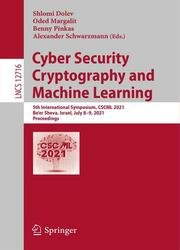Cyber Security Cryptography and Machine Learning: 5th International Symposium, CSCML 2021
- Добавил: literator
- Дата: 2-07-2021, 11:56
- Комментариев: 0
 Название: Cyber Security Cryptography and Machine Learning: 5th International Symposium, CSCML 2021
Название: Cyber Security Cryptography and Machine Learning: 5th International Symposium, CSCML 2021Автор: Shlomi Dolev, Oded Margalit, Benny Pinkas
Издательство: Springer
Год: 2021
Страниц: 520
Язык: английский
Формат: pdf (true), epub
Размер: 41.2 MB
This book constitutes the refereed proceedings of the 5th International Symposium on Cyber Security Cryptography and Machine Learning, CSCML 2021, held in Be'er Sheva, Israel, in July 2021.
The 22 full and 13 short papers presented together with a keynote paper in this volume were carefully reviewed and selected from 48 submissions. They deal with the theory, design, analysis, implementation, or application of cyber security, cryptography and Machine Learning systems and networks, and conceptually innovative topics in these research areas.
Topics of interest for CSCML include cyber security design; secure software development methodologies; formal methods, semantics and verification of secure systems; fault tolerance, reliability, and availability of distributed secure systems; game-theoretic approaches to secure computing; automatic recovery self-stabilizing and self-organizing systems; communication, authentication, and identification security; cyber security for mobile systems and the Internet of Things; cyber security of corporations; security and privacy for cloud, Edge and Fog computing; cryptocurrency; blockchain; cryptography; cryptographic implementation analysis and construction; secure multi-party computation; privacy-enhancing technologies and anonymity; post-quantum cryptology and security; Machine Learning and Big Data; anomaly detection and malware identification; business intelligence and security; digital forensics, digital rights management; trust management and reputation systems; and information retrieval, risk analysis, and DoS.
Contents:
Скачать Cyber Security Cryptography and Machine Learning: 2021
Внимание
Уважаемый посетитель, Вы зашли на сайт как незарегистрированный пользователь.
Мы рекомендуем Вам зарегистрироваться либо войти на сайт под своим именем.
Уважаемый посетитель, Вы зашли на сайт как незарегистрированный пользователь.
Мы рекомендуем Вам зарегистрироваться либо войти на сайт под своим именем.
Информация
Посетители, находящиеся в группе Гости, не могут оставлять комментарии к данной публикации.
Посетители, находящиеся в группе Гости, не могут оставлять комментарии к данной публикации.

